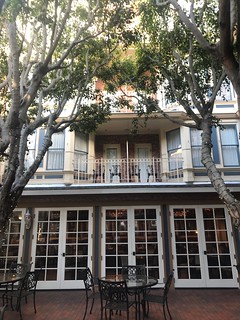
During my first visit to San Diego I remember walking across a busy street and set of train tracks from the Convention Center to the Gaslamp Quarter (or Gaslamp District, depending who you ask.) According to the big sign crossing Fifth Avenue the Gaslamp is the self-proclaimed “Historic Heart of San Diego.”
The neighborhood’s promotional pamphlets had already turned me off somewhat, and on seeing this stretch of the Gaslamp my tourist trap sensor went off — all the restaurants on the block had barkers out front.
Today that particular stretch of the Gaslamp is even more tourist trap-y with the addition of a Hard Rock Cafe. You can poke around on Google Street View here to see for yourself.
So I was a little apprehensive about signing up for a walking tour of a neighborhood that seemed so touristy. But the organization behind the tour appeared legitimate and I’m always down for an interesting walking tour.
This Gaslamp walking tour is specifically the Gaslamp Foundation Thursday Walking Tour although from what I understand you can book the same tour on Saturdays.
The tour meets at the Davis-Horton House Museum, which is operated by the same organization behind the tour.
Early on, the tour throws some shade on that big Gaslamp Quarter sign’s claim to be the “historic heart” of San Diego. The original inhabitants of San Diego were Native Americans, a claim easily verified by anyone familiar with California’s Spanish history — the first Mission was built in San Diego in 1769 to convert the natives to Catholicism — and it’s pretty far away from the Gaslamp.
Second the Gaslamp was originally known as New Town, promoted as the new downtown San Diego, much closer to the port (now where the Convention Center is located) than Old Town further up north. Old Town is still preserved in some capacity and is another tourist attraction. So there’s that.
But by far the biggest blow to the image promoted to tourists about the Gaslamp are the “gas lamps” themselves. Those ye olde fashioned (electric) light posts lining the streets were installed in the 1980’s when city planners became interested in preserving the area, and rebranded it as the “Gaslamp Quarter.” Although gas lamps were installed inside buildings back in the day, the streets themselves never actually had gas lamps illuminating them at night.
Before the Gaslamp rebranding, New Town was known locally as the Stingaree. Nobody calls it that anymore. Marketing is a powerful force.
A few highlights of the tour:
- Many of the Victorian buildings were renovated to “modernize” or strip them of the Victorian elements after World War 2. Some of them were recently renovated back to appear Victorian again based on photos or even molds of other buildings. To me the ways we “preserve” history say more about the prevailing fashions at the time than anything meaningful about history.
- San Diego’s Chinatown (or Asiatown, really) once included part of today’s Gaslamp. It’s all but forgotten unless you know where to look. Even then there’s little left to see.
- Several buildings were moved one way or another, including the Davis-Horton House as well as the nearby Horton Grand Hotel. The Horton Grand Hotel was originally two hotels, ripped down, put into storage, and eventually rebuilt as a single hotel in a different location. This explains why one side has trapezoidal bay windows and the other features rectangular bay windows.
- Buildings near a port often served as brothels because, you know, sailors. The photo of the ornate Victorian above is a semi-recreation of a building that once housed a particularly well known brothel. The madam sold color-coded marbles, with each color corresponding to a painted door leading to a sex worker in the building. Authorities cracking down on brothels in the area — and there were many brothels — couldn’t touch this simple marble saleswoman. As if that’s not enough supposedly Wyatt Earp frequented the place, but supposedly only the restaurant on the bottom floor.
There’s much more to the tour than this, and my tour guide pointed out that you can wander around and read the historical plaques tacked on to the sides of many historic buildings in the area. That said the early history of the area is often more colorful and complex than the plaques would have you believe.
Our tour entered several buildings to point out historical details not visible from the outside, but officially this walking tour only includes the interior of the Davis-Horton House. That said many of the older buildings in the Gaslamp Quarter are open to the public to some extent (stores, restaurants, etc.) so you can take a peek inside on your own to get a feel for 19th century San Diego.
My recommendation: If you’re interested in the history and architecture of the west coast, go for it. For that matter the tour’s worth checking out if you’re curious about the ways history is preserved, or even what’s considered to be historic. Turns out there’s far more to San Diego’s history than navy operations and beaches. Who knew?


